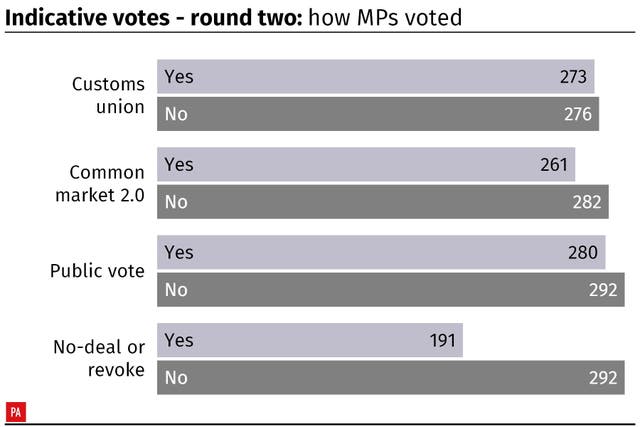Theresa May will seek to break the Brexit deadlock as she gathers her Cabinet for a marathon session of crisis talks in Downing Street.
The Prime Minister and her senior ministers will take stock after MPs again failed to find a majority for a series of alternatives to her Brexit deal.
A call for a customs union with the EU was rejected by just three votes, while a demand for a second referendum was defeated by 12 and a Norway-style deal put forward by Nick Boles by 21.
To cap a dramatic day in the Commons, Mr Boles immediately declared that he would no longer sit as a Conservative MP, blaming the party for refusing to compromise on a means of leaving the European Union.
Cabinet will meet on Tuesday for five hours to thrash out a way forward.
The first three hours will be without civil servants, fuelling speculation the senior Tories could use the time to consider a snap election, the timing of the Prime Minister’s exit from office or to air the bitter grievances between the Leave and Remain wings of the ministerial team.
The failure of any option to gain a majority in the Commons left the UK no clearer about its direction with the prospect of a no-deal Brexit on April 12.
Brexit Secretary Stephen Barclay told MPs that if they wanted to secure a further delay from the European Union, the Government must be able to put forward a “credible proposition” as to what it would do.
But he held out the prospect of leaving with a deal next month – as long as MPs back one.

He said: “If the House were to agree a deal this week, it may still be possible to avoid holding European Parliamentary elections.”
Secretary of State for Health and Social Care Matt Hancock pleaded with MPs to back the Prime Minister’s deal “and deliver Brexit”.
Now, please, can we all just vote for the deal and deliver Brexit
— Matt Hancock (@MattHancock) April 1, 2019
But European Parliament Brexit coordinator Guy Verhofstadt said the votes meant “a hard Brexit becomes nearly inevitable”.
He suggested that Wednesday, when MPs may have a third attempt at reaching a majority, was the “last chance to break the deadlock or face the abyss”.
The House of Commons again votes against all options. A hard #Brexit becomes nearly inevitable. On Wednesday, the U.K. has a last chance to break the deadlock or face the abyss. https://t.co/iixDhr5t6N
— Guy Verhofstadt (@guyverhofstadt) April 1, 2019
After a debate disrupted by semi-naked climate change protesters in the public gallery, “indicative votes” were again held in an attempt to establish what outcome might have majority support among MPs following a similar process last week.
Labour leader Jeremy Corbyn said it was “disappointing” that no Brexit solution secured a majority, but the margin on the customs union motion was “very narrow indeed” compared with three “overwhelming” defeats for the Prime Minister’s Withdrawal Agreement.
I am resigning the Conservative whip with immediate effect. The Conservative Party has shown itself to be incapable of compromise so I will sit as an Independent Progressive Conservative.
— Nick Boles MP (@NickBoles) April 1, 2019
MPs have control of proceedings in the Commons for a third time on Wednesday, but Speaker John Bercow said it was not yet clear what debates and votes will be staged.
The mastermind of the plan, Conservative former minister Sir Oliver Letwin, is expected to set out his proposals on Tuesday.
Tory Brexit hardliners pressed the Prime Minister to now take a tougher line with Brussels.
Tory MP and European Research Group (ERG) vice-chairman Mark Francois said: “This evening, an attempted coup took place in the House of Commons, involving leading members of the Cabinet and backbenchers to prevent Brexit. The coup failed.”
Former Brexit minister and senior ERG figure Steve Baker said Mrs May should seek changes to the Withdrawal Agreement – something the EU has repeatedly ruled out.
“If the EU won’t move then it will be necessary to move out of the EU with no Withdrawal Agreement,” he told the BBC.
Analysis of Monday’s votes showed some 25 Labour MPs rebelled against their party whip to vote against the Boles plan, tabled under the banner Common Market 2.0.
Just 33 Conservatives backed the scheme, which would keep the UK in the single market with a “comprehensive customs arrangement” with the EU after Brexit.
Announcing his decision to quit the Tory benches, Mr Boles said he would now sit as an independent progressive conservative.
“The Conservative Party has shown itself to be incapable of compromise,” he said.
Fifteen Conservative MPs and 203 from Labour – including Mr Corbyn – were among the 280 who voted in favour of a confirmatory referendum for any Brexit deal agreed in the Commons, but they were outnumbered by the 292 voting against, who included 24 Labour MPs.
Ken Clarke’s customs union plan won 273 votes, including 37 Conservatives. The 276 votes against included the vast majority of Tory MPs and 10 from Labour.
SNP MP Joanna Cherry’s proposal to give MPs the power to block a no-deal Brexit by voting to revoke Article 50 was rejected by a margin of 101 votes.
Conservatives had been given a free vote, but Cabinet ministers abstained.
Despite seeing her deal defeated for a third time last week, the Prime Minister is determined to bring it back to the Commons again in a final roll of the dice before the EU deadline of April 12.
But the Democratic Unionist Party reconfirmed its opposition and Conservative backbencher Richard Drax apologised in Parliament for “making the wrong call” when he switched to back the PM on Friday.
